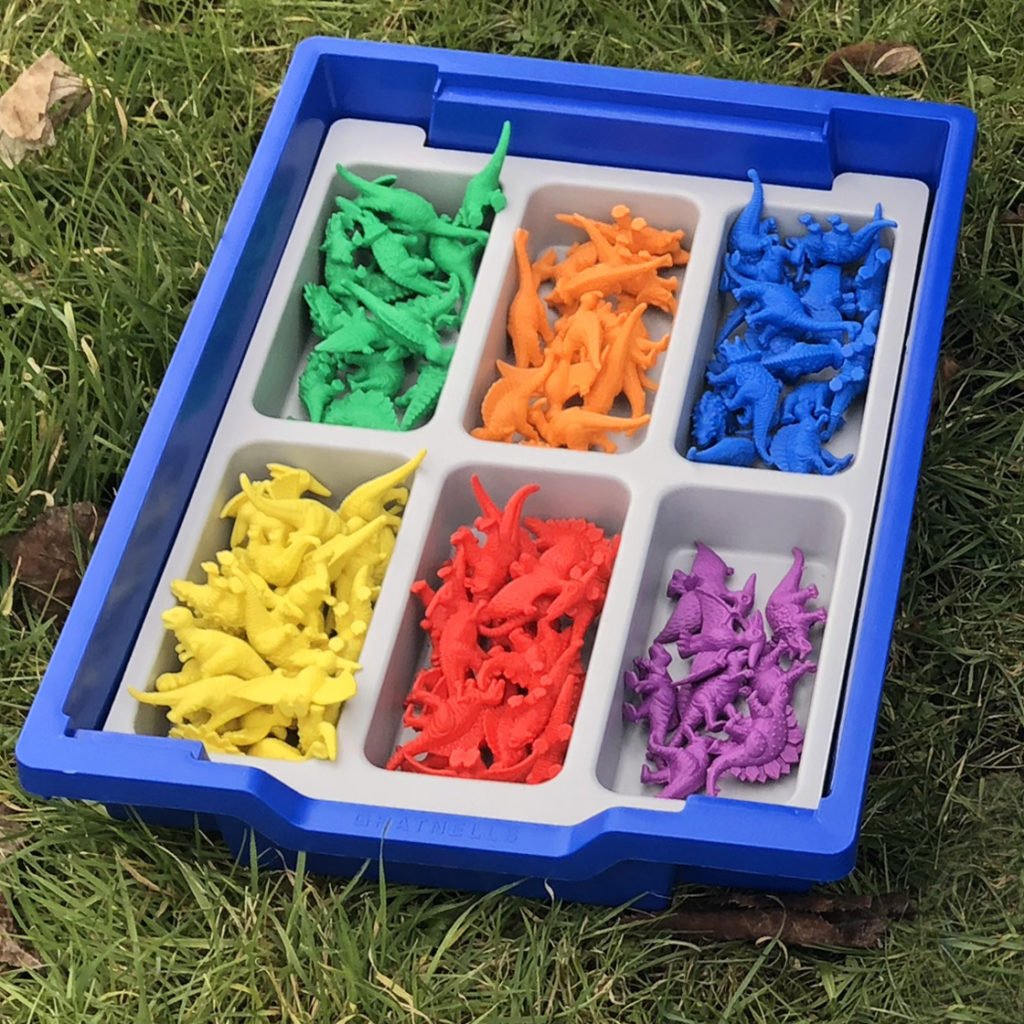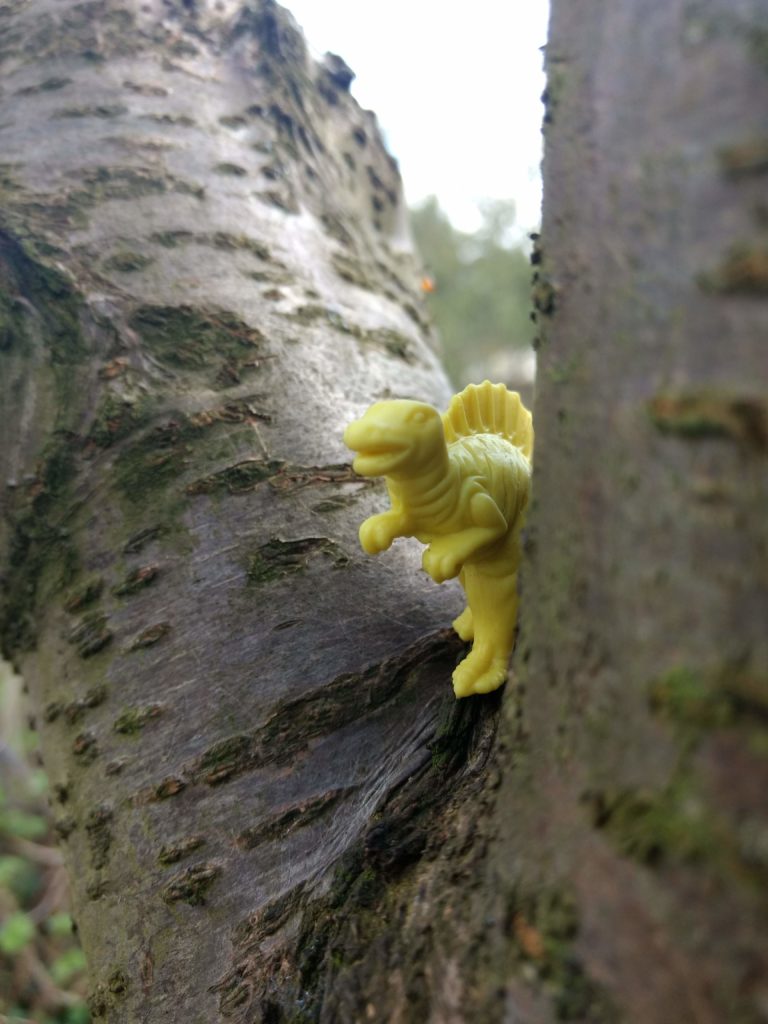Dinosaur hunt
Go on a dinosaur hunt, test out your observation skills and investigate which colour provides the best camouflage. A great opportunity for grouping, sorting and counting outdoors too.

You will need (per group of 30):
- 6 x Shallow Gratnells (F1) Trays, one in each of the following six colours – plum purple, flame red, royal blue, sunshine yellow, grass green, tropical orange.
- 1 x Set of Edx Education Dinosaur Counters
- 1 x Timer or stopwatch
- 1 x Set of football type cones to mark your working area if needed (optional)
- 6 x Mini whiteboards and dry wipe pens with erasers (optional)
Preparation:
- Scatter and hide (in plain sight) all the dinosaurs in a well-defined, leafy, area of your school grounds, ideally with good ground cover and plant variety. Be sure to evenly distribute the colours to ensure a fair test. Place them on the ground and at different heights where possible but ensure they are always in easy reach of the activity participants. Be sure to avoid nettles and thistles etc.
- You may like to take some photographs of the hidden dinosaurs to show to the participants while introducing the activity, just so they know what they are looking for.
- Put one 6-section tray insert into each of the six different coloured shallow Gratnells trays.
This activity can be repeated as many times as required.
What to do:
- Split the participants into six teams.
- Give each team a different coloured tray containing a 6-section insert.
- Place the trays on the ground in a circle or a line, being sure to leave enough room around each tray for all participants to access them easily. Each group stands with their own tray.
- Explain that they will be given 60 seconds* to search a defined area for hidden dinosaurs. Specify the defined area you have allocated for the activity if it has not been marked with cones. When they find a dinosaur, they should bring it back and put it into their team’s tray before heading out to find another one. They should only collect one dinosaur at a time. Colour is not important, they should just pick up the first dinosaur they see and bring it back.
- If the ground is wet or slippery underfoot, participants should be instructed not to run to reduce the risk of slips and falls.
- If you wish to make it a competition, tell participants that the winning team will be the one that collects the most dinosaurs.
- Give a countdown, 3, 2,1, GO! Releasing all the participants* to hunt for dinosaurs.
- Time 60 seconds, or less time if the area is small or the group is very quick*, you are looking for about half the total number of dinosaurs you spread out to be collected, which will be around 10 per tray.
- *If the area is small or collection is likely to be too rapid, this can be run as a relay race, allowing only one participant from each team at a time to hunt, swapping with the next participant once a dinosaur has been found and placed in the team’s tray. Allow each participant a minimum of two turns.
- When around 10 dinosaurs per team have been collected, stop the hunt and call all teams back to their trays.
- Ask each team to count the total number of dinosaurs they have collected. Optional: distribute the mini whiteboards and ask each team to write down and hold up their total, ask the participants to put the totals in size order and work out which team collected the most. Announce one team to be the winner.
- Take photographs of your trays and scores as you go along to evidence your work.
- Ask each team to group and sort their dinosaurs by colour, using their 6-section tray insert, use one section for each colour. Ask each group to shout out, or write on their mini whiteboard, how many of each colour they have found.
- Ask all participants to pick up one dinosaur from their own team’s tray and place it into the tray that matches the colour of the dinosaur. Repeat until all dinosaurs are in their matching coloured tray.
- Ask each team to count the total number of single coloured dinosaurs now in their tray. Ask each group to shout out, or write and display on their mini whiteboard, the number they have in their tray.
- Which is the most frequently found colour? Which is the least frequently found? Why?
- Allow another period of dinosaur hunting, following the same procedure as the first. Allow each participant to find at least one more dinosaur. They should place their finds into the matching coloured tray.
- Stop the hunt and call all teams back to their trays.
- Count again how many is in each tray. Which is the most frequently found colour? Which is the least frequently found?
- Do a final dinosaur hunt to seek out the last remaining dinosaurs, which colour is the most difficult to find?

Tidy up time:
- Check all dinosaurs have been recovered.
- Store all dinosaurs, grouped by colour, in a single shallow Gratnells tray with 6-section insert ready for future use.
What is happening?
The colour of an animal’s skin can either help it hide and blend into its surroundings or make it stand out, to attract attention. There are four main types of camouflage:
- Concealing colouration, or blending, is when animals are the same colour as their surroundings.
- Disruptive colouration, or patterning, breaks up the outline of an animal so they are more difficult to see. Spots, stripes and patterns are the best way to do this. Some animals also use bold patterns and colours to stand out and ward off predators.
- Disguise is when animals blend in with their surroundings by mimicking another object, almost like they are wearing a costume. Common objects that are mimicked include leaves, thorns, twigs and bark.
- Mimicry is when animals look like other, more dangerous, bad tasting or poisonous animals. This fools the predators and scares them away. This can also include body colouration to create the look of eyes, which protects more vulnerable parts of their body or acts as a deterrent to predators.
Can you think of some example animals to put into each camouflage category?
Which colour dinosaur was the best at concealing colouration?
Other things to try…
- Involve the students in hiding the dinosaurs for each other.
- Record your data as you go along, create a bar chart of the number of dinosaurs found of each colour at each stage of the activity.
- Do some research and look at pictures and videos of other animals who have interesting coloured skin. How does this help them survive? What other adaptations do those animals have?
- Make your own dinosaur models or pictures and, using what you have learnt about the different types of camouflage, paint or colour them in to either be the best camouflage possible (prey) or the least camouflage colour possible (predator or warning colouring). Take photographs of your creations. Use your models to carry out another camouflage investigation and grouping and sorting activity.
- If you were going to carry out a dinosaur hunt in a different ecosystem, e.g. on a beach or playground, would you get the same results? On your playground, or if you go on a field trip, you could investigate this and make a prediction as to which colour will be the easiest and most difficult to find.
- Share your photographs of your dinosaur hunt, grouping, sorting and model creations on social media using #WhatsInMyTray.
Health & Safety
As with all Gratnells Learning Rooms What’s In My Tray activities, you should carry out your own risk assessment prior to undertaking any of the activities or demonstrations.

